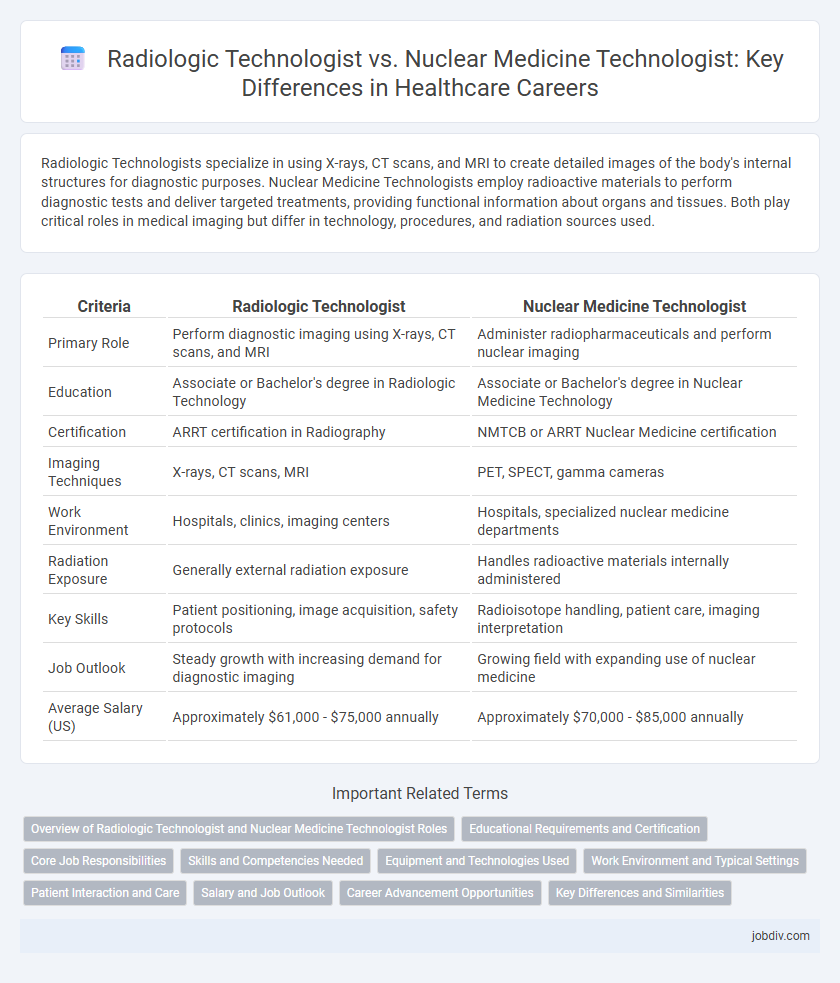Radiologic Technologists specialize in using X-rays, CT scans, and MRI to create detailed images of the body's internal structures for diagnostic purposes. Nuclear Medicine Technologists employ radioactive materials to perform diagnostic tests and deliver targeted treatments, providing functional information about organs and tissues. Both play critical roles in medical imaging but differ in technology, procedures, and radiation sources used.
Table of Comparison
| Criteria | Radiologic Technologist | Nuclear Medicine Technologist |
|---|---|---|
| Primary Role | Perform diagnostic imaging using X-rays, CT scans, and MRI | Administer radiopharmaceuticals and perform nuclear imaging |
| Education | Associate or Bachelor's degree in Radiologic Technology | Associate or Bachelor's degree in Nuclear Medicine Technology |
| Certification | ARRT certification in Radiography | NMTCB or ARRT Nuclear Medicine certification |
| Imaging Techniques | X-rays, CT scans, MRI | PET, SPECT, gamma cameras |
| Work Environment | Hospitals, clinics, imaging centers | Hospitals, specialized nuclear medicine departments |
| Radiation Exposure | Generally external radiation exposure | Handles radioactive materials internally administered |
| Key Skills | Patient positioning, image acquisition, safety protocols | Radioisotope handling, patient care, imaging interpretation |
| Job Outlook | Steady growth with increasing demand for diagnostic imaging | Growing field with expanding use of nuclear medicine |
| Average Salary (US) | Approximately $61,000 - $75,000 annually | Approximately $70,000 - $85,000 annually |
Overview of Radiologic Technologist and Nuclear Medicine Technologist Roles
Radiologic Technologists specialize in performing diagnostic imaging examinations such as X-rays, CT scans, and MRIs to assist physicians in diagnosing injuries and diseases. Nuclear Medicine Technologists administer radioactive medications and use specialized imaging equipment to visualize physiological processes, aiding in the diagnosis and treatment of conditions like cancer and cardiovascular diseases. Both roles require extensive technical knowledge, patient care skills, and adherence to safety protocols involving radiation exposure.
Educational Requirements and Certification
Radiologic Technologists typically require an associate degree in radiologic technology and must obtain certification from the American Registry of Radiologic Technologists (ARRT). Nuclear Medicine Technologists often complete an associate or bachelor's degree in nuclear medicine technology and must be certified by the Nuclear Medicine Technology Certification Board (NMTCB) or the ARRT with a nuclear medicine credential. Both professions demand clinical experience and continuing education to maintain certification and stay current with technological advancements.
Core Job Responsibilities
Radiologic Technologists specialize in performing diagnostic imaging procedures such as X-rays, CT scans, and MRIs to help diagnose and monitor medical conditions. Nuclear Medicine Technologists handle radioactive materials to conduct functional imaging tests, including PET scans and bone scans, providing detailed insights into organ function and cellular activity. Both roles require expertise in patient care, radiation safety, and operation of specialized imaging equipment to produce accurate diagnostic results.
Skills and Competencies Needed
Radiologic Technologists require expertise in operating X-ray, CT, and MRI equipment with a strong understanding of anatomy, radiation safety, and image analysis. Nuclear Medicine Technologists need skills in handling radioactive materials, proficiency in patient preparation, and knowledge of nuclear imaging techniques to diagnose and treat diseases. Both roles demand attention to detail, patient care abilities, and adherence to strict safety protocols to minimize radiation exposure.
Equipment and Technologies Used
Radiologic Technologists primarily operate X-ray, CT, and MRI machines to create diagnostic images using ionizing radiation and magnetic fields. Nuclear Medicine Technologists utilize gamma cameras, PET scanners, and radiopharmaceuticals to visualize physiological processes at the molecular level through radioactive tracers. Both professions require specialized knowledge of imaging technologies and radiation safety to optimize diagnostic accuracy and patient care.
Work Environment and Typical Settings
Radiologic Technologists commonly work in hospitals, outpatient clinics, and diagnostic imaging centers where they perform X-rays and CT scans. Nuclear Medicine Technologists primarily operate in nuclear medicine departments within hospitals and specialized imaging facilities, handling radioactive materials for diagnostic and therapeutic purposes. Both professions require adherence to strict safety protocols but differ in exposure risks and equipment used in their respective clinical environments.
Patient Interaction and Care
Radiologic Technologists primarily perform imaging procedures such as X-rays and CT scans, requiring direct patient positioning and clear communication to ensure accurate images and patient comfort. Nuclear Medicine Technologists administer radiopharmaceuticals, monitor patients during scans, and provide detailed explanations to alleviate anxiety about radioactive substances. Both roles demand strong interpersonal skills to maintain patient safety, provide emotional reassurance, and optimize diagnostic outcomes through effective patient interaction and care.
Salary and Job Outlook
Radiologic Technologists typically earn a median annual salary of around $63,710, while Nuclear Medicine Technologists have a higher median salary, approximately $79,590 per year, reflecting the specialized nature of nuclear medicine procedures. Employment growth for Radiologic Technologists is projected at 6% from 2022 to 2032, aligning with average job market expansion, whereas Nuclear Medicine Technologists are expected to see job growth closer to 9%, driven by increasing demand for advanced diagnostic imaging. Both roles are vital in medical imaging, but the nuclear medicine field offers stronger salary prospects and faster employment growth due to technological advancements and expanding healthcare needs.
Career Advancement Opportunities
Radiologic Technologists can advance by specializing in areas such as MRI, CT, or interventional radiology, often leading to supervisory or education roles. Nuclear Medicine Technologists have opportunities to progress into roles involving PET imaging, radiopharmaceutical preparation, or nuclear cardiology, with potential growth into clinical management or research positions. Both careers benefit from ongoing certification and advanced training to increase responsibilities and leadership potential within healthcare facilities.
Key Differences and Similarities
Radiologic Technologists specialize in diagnostic imaging techniques such as X-rays, CT scans, and MRIs, while Nuclear Medicine Technologists use radioactive substances to perform functional imaging and diagnostic tests like PET scans. Both professionals operate advanced imaging equipment and work closely with patients to capture critical diagnostic information. Training for Radiologic Technologists typically emphasizes anatomy and radiation safety, whereas Nuclear Medicine Technologists focus more on radiopharmaceuticals and nuclear imaging protocols.
Radiologic Technologist vs Nuclear Medicine Technologist Infographic

 jobdiv.com
jobdiv.com